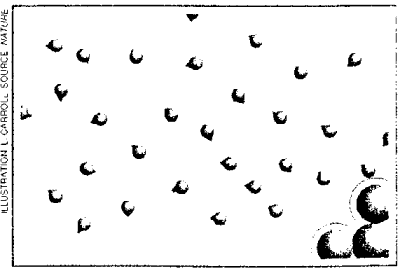 |
Science Frontiers ONLINE No. 117: May-June 1998 |
|
|
More Disorder Here Produces Order There
Physicists use the word "entropy" to describe the well-observed tendency of the universe to run down; that is, become more disorderly. In some situations, though, the increase in disorder (entropy) in one part of the universe can create order elsewhere. For example, if you add tiny plastic spheres of two sizes to salty water, you will not get a uniform mixture. Instead the larger spheres will pack together into tightly ordered crystaline shapes (representing more order) while the smaller spheres become more disordered. It is like watching cream unstir itself from coffee. It smacks of magic, but it is all within the laws of thermodynamics.
This strange "force" exerted by entropy may explain some puzzling biological phenomena, such as the expulsion of nuclei from mammalian red blood cells before they enter the bloodstream as sacks of hemoglobin. The idea being that the increasing entropy of the proliferating hemoglobin molecules (analogous to the smaller spheres) is maximized when the nuclei (large spheres) are squeezed out of the cells altogether.
(Kestenbaum, David; "Gentle Force of Entropy Bridges Disciplines," Science, 279:1849, 1998.)
Comments. The red-blood-cell example presented in the article is on shaky ground, because while mammalian red blood cells do lack nuclei those of birds and reptiles retain theirs. (See BMC6 in Mammals II.)
In the above context, the origin of life (more order) anywhere in the universe can be thought to be due to the "gentle force" of entropy; that is, the result of increasing disorder elsewhere. See? It's all very simple!!
 | When many smaller spheres are added to a sytem of larger spheres, the "gentle force" of entropy "pushes" the latter into a corner and a state of higher order |